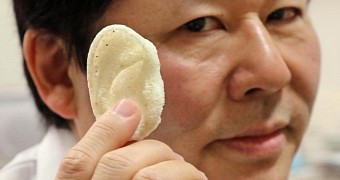There have already been a few surgeries which concluded with peoples' natural joints being replaced by 3D printed, synthetic ones, but it's not quite the same as artificially recreating real bones and organs. We might not have to wait as long as expected for that to become possible though.
Previously, estimates given by bioengineers said that it would be several years before we could reproduce human tissue well enough to be used in transplants.
Japanese researchers believe that it won't take nearly as long for 3D bioprinted bones to be created and used in humans, however. In trial basis anyway.
A team led by Tsuyoshi Takato, a professor at the University of Tokyo Hospital, has built a new 3D bioprinter that can create custom-fit bone and tissue.
The new 3D bioprinting technique
The new printer created by the Japanese scientists can, or will eventually have the ability to, produce skin, bone, cartilage and joints.
The process uses a synthetic substance similar to human collagen to mimic the structure of the organs about to be reproduced. The other half of the process revolves around stem cells.
The implants are built based on Computer Tomography (CT) scans of the patient, and are meant to be assimilated by real tissue and organs of the patient.
The use of biological substances plays a key role here, though the stem cells are even more important, as they are, by nature, capable of developing into nearly any body part.
Interesting to note is that the artificial protein (the collagen knock-off as it were) has a very amusing source. It was discovered by a company that was trying to see if collagen could be used in photographic film, of all things.
Applications for the new implants
One of the biggest pluses is that implants applied to children won't cause problems over time anymore. Synthetic joints and bones would have to be replaced repeatedly, due to them being rendered obsolete by the natural growth of the patient.
It's the main reason why many people don't even bother with them, although sometimes the pain or disability is so bad that it's better to get the implant than the alternative.
Having an essentially bio-integratable implant like this means that a replacement joint or bone will become part of / be replaced by natural tissue over time and grow as normal.
The new bioprinter can produce artificial bones with details and shaping accuracy of 100 microns (0.1 mm).

 14 DAY TRIAL //
14 DAY TRIAL //